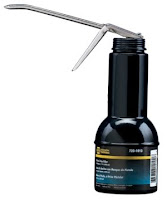The brake fluid was added tonight. I used a Balkamp BK 7201013 1 pint oiler hand pump from Napa and Royco 782 hydraulic fluid with some 1/8" clear tubing from Lowe's.
It's a fairly simply process: Puncture the can with a bottle opener, pour some of its "nectar of arrest" into the oiler, attach one end of the clear tubing to the can and the other to the zerk nut (bleeder valve in red in the below right image) of a brake. Then unscrew the zerk nut with your fingers until it just comes loose.
Apply pressure to the oil can pumping handle and slowly continue to loosen the zerk nut until the pressure on the oil can handle diminishes. At this point you're assured that the zerk nut is opened enough to pass fluid into the brake system but still not opened enough to pass the fluid out of the fitting. However, I kept the zerk nut wrapped in paper towels since I couldn't prevent fluid from leaking. Be weary of pumping air into the system.
Fluid will start to fill the system associated with the side of the airframe you're filling from. In my case, I filled from the left side first. I continued filling until the master cylinder was about half full.
Then I filled the right side.
I didn't see any air bubbles in the system and the brake pedals were not spongy, suggesting no air in the system, which is frankly unbelievable. However, after letting the system sit for several weeks, the air bubbles slowly worked their way up to the highest point in the tubes. Apologies for the poor quality images, it was difficult to coax the camera to focus on the desired subject, however you can see an air bubble in each line as those lines feed into the fluid reservoir.
Before clearing these bubbles, a friend of mine helped me rock and push the pedals up and down through their full travel multiple times. We were able to release even more air previously hidden in the master cylinders. Then, I drained the fluid reservoir with a syringe and we slowly pushed in more fluid through the zerk nuts so that the air could pass into and out of the reservoir.
Currently, I see no air in the system, however it is apparently normal for more air to work out as the aircraft is flown. In fact, when I visited Van's on 7-Aug-14, you can see in an image I took of their demonstrator, N214VA, they too had air. Look closely at the very top center of the image.
After the rudder was attached, I verified the position of the rudder pedals as I put them as far forward as possible. With the seats in and rudder on, that positioning worked great for me (the air bubble at the left cylinder was removed during the process outlined above).














No comments:
Post a Comment